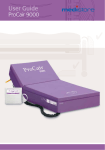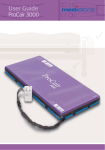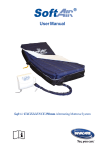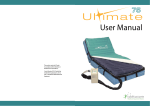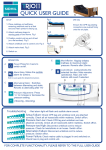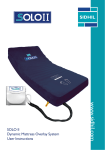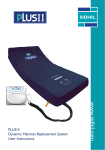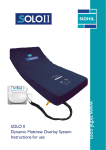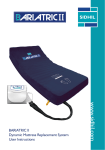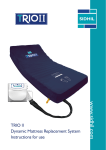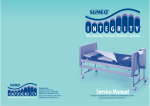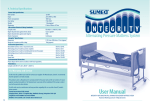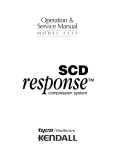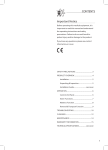Download 0191A Premium 10 User Guide.indd
Transcript
User Guide 10 Digital Important Notice Before operating this medical equipment, it is important to read this User Guide and understand the operating instructions and safety precautions. Failure to do so could result in patient injury and/or damage to the product. Page Safety Precautions 4-5 Product Overview 6 Installation 7 Unpacking & Inspection 7 System Installation 8 Control Unit Installation 8 Operation 9 Control Unit Panel 9 Mattress Function 10 Alarm Functions 11 Removal & Transport Function 12 Troubleshooting 13-14 Cleaning 15-16 Maintenance 17 Technical Specifications 18 Warranty Information 19 Safety Precautions The purpose of safety precautions are to attract your attention to possible dangers. The safety symbols and the explanations with them, require your careful attention and understanding. The safety warnings by themselves do not eliminate any danger. The instructions or warnings they give are not substitutes for proper accident prevention measures. The following symbols may appear in this User Guide, on the Control Unit, or on its accessories. Some of the symbols represent standards and compliances associated with its use. SAFETY ALERT SYMBOL: Indicates caution or warning. WARNING: Failure to obey a safety warning can result in serious injury to yourself or to others. Always follow the safety precautions to reduce the risk of fire, electric shock and personal injury. DOUBLE INSULATION Double insulation is a safety concept of electrical equipment which eliminates the need for earth grounding. Whenever there is electric current in the Control Unit there are two complete sets of insulation to protect the user. All exposed metal parts are isolated from the internal metal motor components with protecting insulation. 4 WARNING: The double insulated system is intended to protect the user from shock resulting from a break in the Control Unit’s internal wiring. Observe all normal safety precautions related to avoiding electrical shock. WARNING: Servicing a Control Unit with double insulation requires extreme care and knowledge of the system and should only be performed by a qualified service technician. For service we suggest you return the Control Unit to your nearest Novis Healthcare Authorised Service Centre for repair. When servicing, use only identical replacement parts. OPERATING INSTRUCTIONS WARNING: Do not attempt to operate this product until you have thoroughly read and completely understand the safety rules, etc contained in this User Guide. Failure to comply can result in accidents involving fire, electric shock or serious personal injury. Save owner’s User Guide and review frequently for continual safe operation and for instructing others who may use this product. Maximum recommended patient weight for this system is 250kg. Only the Control Unit and Mattress combination as recommended by Novis Healthcare should be used, otherwise the correct function of this product cannot be guaranteed Safety Precautions In General WARNING: This device is not suitable for use in the presence of a flammable anaesthetic mixture with air, or in the presence of a flammable anaesthetic mixture with oxygen or nitrous oxide. WARNING: Bed frames used with the systems can vary greatly depending on the specific health care setting (ie hospitals, nursing homes, home care, etc). It is the responsibility of the caregiver to take the necessary precautions to ensure the safety of the patient. This includes, but is not limited to, the appropriate use of side rails to prevent falls and/or patient entrapment. IMPORTANT: Minimise articles between the system surface and patient, and secure bed sheets loosely so as not to affect the alternating cell movement. WARNING: Significant risks of reciprocal interference may be posed by the presence of the system during specific investigations or treatments. Potential electromagnetic or other interference between the system and other devices may occur. If interference is suspected, move equipment from sensitive devices or contact Novis Healthcare. Control Unit Only plug into a grounded power receptacle and use the power cord supplied with the system. Exposure of the electronic Control Unit to any liquid while it is plugged in could result in a severe electrical hazard. Novis Healthcare recommends placing the cord under the bed frame and attaching it to an electrical outlet by the head of the bed. The power cord to the Control Unit should be positioned to avoid a tripping hazard and/or damage to the cord. Do not place any objects or items, such as blankets, on or over the Control Unit. The electronic Control Unit is a precision electronic product. Use care when handling or transporting. Dropping or other sudden impacts may result in damage to the unit. Before attaching the Control Unit to the floor or the foot board of the bed, ensure they are sufficiently robust and free of damage. WARNING: Do not open the Control Unit – risk of electrical shock. Do not attempt to repair or service the Control Unit. If parts need to be repaired, circuit diagrams and parts lists can be provided by Novis Healthcare to suitably qualified service personnel. WARNING: Only use fuses that have the same specified rating (see Technical Specifications). Using fuses with higher ratings could result in damage and/or injury. NOTE: No special skills, training or knowledge are required to operate the Control Unit. 5 Product Overview 10 Digital Alternating Mattress System The 10 Digital is an Alternating Mattress System providing pressure application and relief for patients with, or vulnerable to, pressure ulcers. It is designed to be used on either standard or profiling single bed frames. The 10 Digital Alternating Mattress System consists of the following: • Control Unit • Mattress • Power Cord • User Guide • Carry Bag The Control Unit provides the air supply to the Mattress. It is controlled by a digital touch membrane on the front panel which controls eight comfort settings, Alternating or Static Mode for treatment or transfers respectively, and Max Inflate function to facilitate quick mattress inflation. The Alarm LED indicator and Alarm Mute completes the profile. The visible and audible alarm function has a number of indications depending on the cause of the failure. On the side of the Control Unit are four male air connectors for quick connection of air hoses. The connectors include a press button release system on the handle for ease of use. The mains supply to the Control Unit can be easily disconnected and is designed to detach if pulled too firmly – protecting the internal wiring of the unit. 6 The mattress comprises 19 high density cells including 3 static head cells to provide static ‘pillow’ support for optimum comfort. Air pressure in the other 16 cells including the heel zone is alternated over a 12 minute cycle. This provides regular periods of pressure reduction to aid blood and lymphatic flow to vulnerable tissue. The system includes a rapid release CPR tag for emergency deflation. Installation Unpacking & Inspection NOTE: It is recommended that all packing materials and instructions be kept in the carry bag provided, in the event the product has to be shipped to an approved Novis Healthcare Service Centre. Carefully remove the Control Unit, Mattress and accessories from the shipping cartons. Inspect all items for any damage that may have occurred during shipping. Any damage or missing components should be reported to a Novis Healthcare Service Centre as soon as possible. The box should contain the following items: • Completely assembled 10 Digital Mattress System • Carry Bag • Digital Control Unit • Medical Grade Power Cord • User Guide. The Mattress is treated as an applied part. 7 Installation System Installation Control Unit Installation The following describes the procedures to follow upon setting up the system for the first time. a) Position Control Unit by its hanging hooks over foot board of the bed or on the floor under the bed. a) Remove all covers, sheets and Mattress from the existing bed. b) Attach the rapid release handle to the Control Unit. Ensure air hoses do not kink between bed frame and Control Unit. b) Position Mattress Replacement, with its top cover, on top of existing bed and position hose ends at foot of bed for Control Unit. c) In a profiling bed, secure the side straps around the moveable sections of the bed base. DO NOT SECURE TO THE SIDE RAILS – THE STRAPS WILL TEAR OFF! 2 3 1 c) Position the power cord through the cord retention loops along the side of the Mattress base and insert power cord into Control Unit, then into a grounded 240 V AC 50 Hz electrical outlet. d) Press the power button for more than three seconds to activate Control Unit. The pressure LEDs’ will flash indicating that the system has activated. Allow up to 40 minutes for full inflation. 40 min. d) Check CPR hoses connections are pushed fully onto the connectors. e) Confirm there are no sharp objects in the immediate area which may risk damage to the Mattress Replacement. Important: Make sure that the attachment of the Mattress Replacement does not interfere with the movement or operation of the bed. These systems are designed to operate in a controlled environment, which is free from extreme temperatures, high humidity and/or excessive amounts of airborne particles, such as dust and smoke. 8 e) Once ready, the second LED as well as the alternating LED will illuminate to indicate that the system is ready for use (system automatically defaults to alternation mode after startup). f) Once the Mattress Replacement is fully inflated, bedding can be replaced. Secure sheets loosely enough to ensure they do not interfere with cell alternation. g) Transfer the patient to the Mattress and perform a ‘bottoming out’ test to ensure that the patient is properly suspended. Refer to page 10 for more details. Operation Control Unit Panel B C D E F A G A. Power Button E. Pressure Arrow Buttons Turns system power on and off. Press arrows to increase or decrease pressure setting. Eight pressure settings from soft to hard are available (18mmHg to 60mmHg; 6mmHg per step). The green LEDs illuminate to indicate which of the eight settings is operational. B. Alarm LED This red light flashes, and an audible alarm sounds, to alert when Control Unit or Mattress pressure fails. The alarm has five different signals to indicate the cause of the failure. The audible alarm also sounds when power is switched off – press Alarm Mute to silence. C. Alarm Mute Button Silences the audible alarm (on/off). Audible alarm will resume after 20 minutes if cause of failure not resolved. D. Mode Button Press to select either Alternation Mode (alternative cells cyclically inflating and deflating) or Static Mode (all cells fully inflated with no dynamic alternation). F. Max Inflate Button Press to facilitate rapid inflation to maximum pressure setting (60mmHg). After 20 minutes, the system automatically reverts back to the previous pressure setting for patient safety. G. Control Unit Lock/Unlock Button Press for at least three seconds to lock the Control Unit settings – a beep sounds and the amber LED illuminates to indicate system is locked. When locked, only the Alarm Mute and Lock/Unlock buttons remain operational. Press again for at least three seconds to unlock (beep sounds and amber LED turns off). WARNING: the Control Unit will automatically unlock in the event of a power failure. 9 Mattress Function Control Unit Panel Establishing Pressure (supine patient) Establishing Pressure (inclined patient) With the patient lying supine (on their back, face upwards), use the Pressure arrows to cycle through the eight available pressure settings. When moving the patient to a sitting or more upright position, pressure may need to be increased (by approximately 20%) to provide added support and to avoid ‘bottoming out’. Based on patient weight and comfort requirements, establish the best setting for effective alternation, support and comfort. Before changing or lowering the pressure, ensure the system is working effectively by performing a ‘bottoming out’ test: a. With the patient lying supine, unzip one side of the top cover just past sacral region (lower spine). b. Slide your hand underneath the patient and feel for a deflated cell under the patient’s lower spine. The inner static cell will remain inflated, however your hand should easily slide between patient and base. c. If patient is adequately suspended, pressure setting can be lowered. After approximately 20 minutes, reassess system function and patient comfort. In the event of a system malfunction, the alarm will activate and pressure LEDs will flash. IMPORTANT: It is important to return to the original pressure setting when the patient returns to the supine position. IMPORTANT: Wait a minimum of 12 minutes between pressure adjustment and patient assessment, as it may take a full cycle for the system to adjust. CPR Function Rapid deflation of the Mattress System may be required for emergency treatment or to decommission the unit. The CPR tag located at mattress head should be used in the event that patient CPR or emergency treatment is required. Firmly pull the CPR tag to rapidly deflate the entire system, ensuring sealing connectors are firmly disconnected from the internal Mattress System air hoses. To re-inflate the system after the CPR tag has been pulled, restore the CPR sealing connectors to the internal Mattress System air hoses and wait for the system to gain optimal pressure. IMPORTANT: Do not position the system to make it difficult to operate the disconnection device (CPR Tag). 10 Operation Alarm Function The red Alarm LED flashes, and an audible alert sounds, to indicate the Control Unit or mattress pressure has failed. The LED will remain illuminated until appropriate pressure is restored. The audible alarm can be silenced by pressing the Alarm Mute button. The system has five different alarm signals, identified by five different Pressure Setting illumination sequences. The signals and corresponding Pressure Setting LED displays are illustrated below. Display Alarm Signal Initial Failure Mattress has failed to reach minimum operational pressure within 50 minutes Low Pressure Pressure has fallen 5mmHg or more below the setting minimum High Pressure Pressure has exceeded the setting maximum by 10mmHg or more Alternating Mode failure Mattress has failed to commence alternation AC power failure No pressure output due to mains power failure If alarm activates and the system fails to inflate or loses pressure, refer to Troubleshooting on page 13-14. 11 Operation Transport Function Dismantle System 1. Before patient transport, press the Static Mode button to switch modes and wait at least five minutes for cells to inflate to maximum pressure. 1. Press the power button for at least three seconds to switch off the Control Unit. Switch off the mains supply and unplug the power cord. 2. Once mattress pressure has reached maximum inflation, press the Power button for at least three seconds to switch off the Control Unit. Switch off the mains supply and unplug the power cord. 3. Remove the ‘D’ handle from the Control Unit and seal with the attached handle cap. The length of time the air is retained in the Mattress will depend on the weight and height of the individual patient. If the patient is responsive, check comfort level based on current pressure and adjust accordingly. IMPORTANT: Always perform a ‘bottoming out’ test (see page 10) to ensure the patient is adequately supported and not touching bed base. 12 WARNING: Unplug the Control Unit from the mains power supply to disconnect the power. 2. Push the hose connector lever down and unclip handle to disconnect air hoses from the Control Unit. This will deflate all cells except the three static head cells. 3. To deflate the head cells, firmly pull the CPR tag to disconnect the sealing connectors from the internal air hoses. 4. Place Control Unit and power cord on top of the Mattress and detach Mattress from bed. 5. Once air has been released from the cells, roll up the Mattress and return all items to Carry Bag for safe keeping. IMPORTANT: Prior to re-starting the system, ensure the CPR tag is replaced and sealing connectors are fully inserted into the internal air hoses. Troubleshooting Alarm/Fault Display Solution Control Unit does not operate; no display lights illuminate The Control Unit may not be attached to a power source or a fuse may need replacing 1. Check the Control Unit is connected to mains power outlet with the correct voltage. 2. Check the Control Unit is switched on. Switch off and unplug the unit before restarting. 3. Check the mains plug fuse (3 AMP) then check both Control Unit fuses (1 AMP) – fuses can be released using a screwdriver to push and turn. WARNING: Do not try to open the Control Unit. Opening the unit could cause personal injury or equipment damage. Alarm LED Initial failure 1. Reset the alarm – turn off Power and press the Alarm Mute button. 2. Check all air hoses along the inside of the mattress – each should be firmly connected. Check each air cell is securely attached to its connecting air pipe. + audible alarm 3. Check all cells, pipes and hoses for any air leakage. 4. Switch on Power. Alarm LED + audible alarm Pressure too low 1. Reset the alarm – turn off Power and press the Alarm Mute button. 2. Check the CPR tag is intact, ensuring both sealing connectors are firmly fitted to the internal Mattress air hoses. 3. Check all air hoses along the inside of the mattress – each should be firmly connected. Check each air cell is securely attached to its connecting air pipe. 4. Check all cells, pipes and hoses for any air leakage. 5. Check that the air filter cover is correctly secured and the air filter is clean. 6. Switch on Power. 13 Troubleshooting Alarm/Fault Display Solution Alarm LED Pressure too high 1. Reset the alarm – turn off Power and press the Alarm Mute button. 2. Disconnect the air hoses to reduce pressure – reconnect when pressure has decreased. + audible alarm 3. Check for twists in the air hoses between Mattress and Control Unit. 4. Switch on Power. Alarm LED Alternating Mode Failure (no alternation) 1. Reset the alarm – turn off Power and press the Alarm Mute button. AC power failure 1. Press the Alarm Mute button to silence the audible alarm. + audible alarm Alarm LED 2. Disconnect the air hoses to reduce pressure – reconnect when pressure has decreased. 2. Check the power cord is firmly plugged into the mains outlet and the Control Unit; and check the mains power is switched on. + audible alarm 3. Check the mains plug fuse (3 AMP) then check both Control Unit fuses (1 AMP) – fuses can be released using a screwdriver to push and turn. Patient is sinking or ‘bottoming out’ whilst lying flat on the Mattress The pressure maybe set too low for the patient’s weight 1. Increase the pressure setting by pressing up the Pressure arrow. 2. To check effective system performance, conduct a ‘bottoming out’ test as described on page 10. NOTE: If the problem is not resolved, please contact an authorised Novis Healthcare Service Centre. 14 Cleaning Infection Control and routine cleaning must be carried out in accordance with your local Infection Control Policy. It is suggested that all disinfection be done with a high grade disinfectant in accordance with manufacturer’s instructions. NOTE: The top cover seams are sealed to help prevent moisture ingress and bacterial growth in the seam stitching. Mattress Base Once deflated, disconnect air cells from the base by unfastening the press studs at each end. Remove double tubing from main base air tubes and slide the cell out from the cell straps. Swab the cell with a solution of Sodium Hypoclorite or similar (up to 10,000ppm available chlorine). Dry thoroughly before refastening. WARNING: Do not use high temperature autoclave, or use Phenolic based products for cleaning. CAUTION: Do not machine wash or dry the air cells or Mattress base. The air cell assembly does not need to be cleaned or disinfected. IMPORTANT: It is recommended the system is cleaned between patients and approximately every two weeks if in constant use. IMPORTANT: Do not disassemble the Mattress unless cleaning is required. If cleaning or disinfecting is required, do not disconnect the hoses from the air cells. 15 Cleaning Top Cover Control Unit NOTE: Refer to the top cover wash tag for cleaning instructions. WARNING: Ensure the Control Unit is disconnected from the mains electricity supply before cleaning. If there are visible signs of body fluids or other substances, the top cover should be washed. The top cover can be machine washed (up to 40°C) using disinfectant according to manufacturer’s instructions. To determine the amount of disinfectant to use, determine the amount of water in the washer and then follow the manufacturer’s instructions for dilution. Soak the top cover in the disinfectant during the wash cycle. Rinse well in clean water and dry thoroughly before use. CAUTION: Do not dry the top cover using the heat cycle or a dryer. Air dry or select a low or non heat dry cycle. If there are no visible signs of body fluids or other substances, the top cover should be sanitised. Apply an intermediate level disinfectant (or a solution of Sodium Hypochlorite or similar up to 10,000ppm available chlorine) to the top cover surface. Rinse well with a clean damp cloth and air dry before use. 16 WARNING: Do not spray disinfectant directly on to the Control Unit, or immerse the Control Unit in any type of liquid. This could result in a severe electrical hazard as this equipment has no protection against ingress of water. Wipe down Control Unit with warm water containing detergent (or with a solution of Sodium Hypochlorite or similar) and dry thoroughly before use. Maintenance Air Filter Fuse 1. Switch off the power supply to the Control Unit. 1. Switch off the power supply to the Control Unit. 2. Disconnect the power cord and air hoses. 2. Remove the power cord from the electrical socket on the side of the base of the Control Unit. 3. Place the Control Unit on a flat surface with back panel uppermost (place soft cloth under unit to prevent scratches). 4. Carefully remove air filter cover, remove and discard the filter material and fit new filter (there may be a small locking screw – use a small small flat head screwdriver to remove}. 5. Refit the air filter cover to the Control Unit. The Control Unit is now ready for re-connection. 3. Insert a small flat head screwdriver into the groove and turn anti-clockwise (quarter turn). 4. Remove the “blown” fuse from the fuse holder clip and discard. 5. Insert a new fuse into the plug. Push against the force of the spring and turn clockwise with the screwdriver (quarter turn). NOTE: Good filter maintenance is critical to maintain your system in optimal operating condition. Failure to keep the filters clean will result in system downtime and increase repair costs. It is recommended that the air filter be replaced annually. Air filters are available from a Novis Healthcare Service Centre. Preventative inspection and calibration is not required. 17 Technical Specifications Control System Digital micro controller Cycle Time 12 minutes (fixed) Supply Voltage 220-240V AC 50/60Hz 0.2A for Control Unit Fuse Rating Mains Plug – 3AMP, Control Unit – 1AMP (x2) Power Rating 12VA Standards CE, UL No of Cells 19 cell in cells (including 3 static head cells and 5 narrow heel cells) Cell Height 280mm Maximum patient weight 250kg Mattress Dimensions Length 2000mm Width 880mm Height 280mm Weight 11.6kg Control Unit Dimensions Height 270mm Width 315mm Depth 120mm Weight 4.5kg Cell material 0.3mm TPU film laminated on 210 denier nylon fabric Base material Nylon fabric 420 denier with a 0.1mm TPU coating Cover material PU coated polyester Hose Connection Press on dual connector hoses Emergency CPR tag Mode of Operation Non-continuous Operating environment Air humidity 30% to 75% Ambient temperature 0°C to 40°C Altitude ≤ 2000m NOTE: All product specifications are subject to change without notice. 18 Warranty Information Our goods come with guarantees that cannot be excluded under the Australian Consumer Law. You are entitled to a replacement or refund for a major failure and for compensation for any other reasonably foreseeable loss or damage. You are also entitled to have the goods repaired or replaced if the goods fail to be of acceptable quality and the failure does not amount to a major failure. All products returned for warranty repairs must be assigned a Return Authorisation Number prior to return. Returns should include information describing the problem and/or requested repair and be sent to a Novis Healthcare Service Centre by prepaid transportation. Novis Healthcare will return the repaired/replaced product at no charge. Warranty repairs do not extend the length of the warranty period. Novis Healthcare warrants each of its products to perform in accordance with established specifications for the following time periods, starting from the date the product is shipped from Novis Healthcare. Neither Novis Healthcare, its distributors, officers, directors, employees or agents shall be liable for consequential or other damages, including but not limited to personal injury, loss, or any other expense, directly or indirectly arising from the use of its products. The sole remedy for breach of the limited warranty granted herein shall be repair of Mattress or the Control Unit or related parts. Control Units Soft Goods 2 year 2 year During the warranty period, Novis Healthcare through its distributors, will repair or replace at no charge, any products that are not performing in accordance with established specifications, unless the problem/failure is due to: • customer damage, negligence and/or misuse • unauthorised repairs. Items not covered under warranty include, but are not limited to, stains, punctures, cuts, damages to electrical cords, rips or tears, dents and/or lost/missing parts. 19 Novis Healthcare has a policy of continuous product improvement and reserves the right to amend specifications presented in this brochure. This product carries the CE mark in accordance with EC Directive on Medical Devices (93142lE EC) . Control Number 95CG. Classified by Underwriter’s Laboratory Inc. for UL 2601-1 standard for Medical Electrical Equipment. 0191A 11/12 20




















